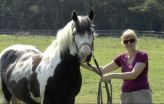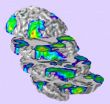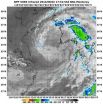(Press-News.org) Horses are sensitive to the facial expressions and attention of other horses, including the direction of the eyes and ears. The findings, reported in the Cell Press journal Current Biology on August 4, are a reminder for us humans to look beyond our own limitations and recognize that other species may communicate in ways that we can't, the researchers say. After all, human ears aren't mobile.
"Our study is the first to examine a potential cue to attention that humans do not have: the ears," says Jennifer Wathan of the University of Sussex. "Previous work investigating communication of attention in animals has focused on cues that humans use: body orientation, head orientation, and eye gaze; no one else had gone beyond that. However, we found that in horses their ear position was also a crucial visual signal that other horses respond to. In fact, horses need to see the detailed facial features of both eyes and ears before they use another horse's head direction to guide them."
The new study also challenges the earlier held notion that animals with eyes to the sides of their heads cannot glean information based on the direction of one another's gaze.
Wathan and the study's senior author Karen McComb took photographs to document cues given by horses when they were paying attention to something. Then Wathan and McComb used those photographs as life-sized models for other horses to look at as they chose between two feeding buckets. In each case, the horse in the photo was paying attention to one of the buckets and not the other. In some instances, the researchers also manipulated the image to remove information from key facial areas, including the eyes and the ears.
The researchers' observations show that horses rely on the head orientation of their peers to locate food. However, that ability to read each other's interest level is disrupted when parts of the face—the eyes and ears—are covered up with masks. The ability to correctly judge attention also varied depending on the identity of the horse pictured, suggesting that individual facial features may be important, the researchers report.
Wathan and McComb plan to continue to explore facial features related to the expression of emotion in their horses, noting that horses' rich social lives and close relationship to humans make them particularly interesting as study subjects. Our understanding of horses' social lives might also have implications for their welfare.
"Horses display some of the same complex and fluid social organization that we have as humans and that we also see in chimpanzees, elephants, and dolphins," Wathan says. "The challenges that living in these societies create, such as maintaining valuable social relationships on the basis of unpredictable interactions, are thought to have promoted the evolution of advanced social and communicative skills. There is a general interest in studying species with this social structure."
INFORMATION:
Current Biology, Wathan et al.: "The eyes and ears are visual indicators of attention in domestic horses."
Horses communicate with their eyes and mobile ears
2014-08-04
ELSE PRESS RELEASES FROM THIS DATE:
Declining intelligence in old age linked to visual processing
2014-08-04
Researchers have uncovered one of the basic processes that may help to explain why some people's thinking skills decline in old age. Age-related declines in intelligence are strongly related to declines on a very simple task of visual perception speed, the researchers report in the Cell Press journal Current Biology on August 4.
The evidence comes from experiments in which researchers showed 600 healthy older people very brief flashes of one of two shapes on a screen and measured the time it took each of them to reliably tell one from the other. Participants repeated ...
Prenatal alcohol exposure alters development of brain function
2014-08-04
In the first study of its kind, Prapti Gautam, PhD, and colleagues from The Saban Research Institute of Children's Hospital Los Angeles found that children with fetal alcohol spectrum disorders (FASD) showed weaker brain activation during specific cognitive tasks than their unaffected counterparts. These novel findings suggest a possible neural mechanism for the persistent attention problems seen in individuals with FASD. The results of this study will be published in Cerebral Cortex on August 4.
"Functional magnetic resonance imaging (fMRI) has been used to observe ...
Mid-level scientists most likely to use new research tools, says study in INFORMS journal
2014-08-04
Scientists in the middle of the status hierarchy, not those at the top or the bottom, are the first to work with easy-to-use commercial products. They are also the most prone to imitate their prior collaborators' use of such commercial kits. These are among the findings of a study of scientists-as-customers appearing in Marketing Science, a journal of the Institute for Operations Research and the Management Sciences (INFORMS).
Nonmonotonic Status Effects in New Product Adoption is by Yansong Hu of the University of Warwick and Christophe Van den Bulte of the University ...
Animalistic descriptions of violent crimes increase punishment of perpetrators
2014-08-04
Describing criminals and criminal activities with animal metaphors leads to more retaliation against perpetrators by inducing the perception that they're likely to continue engaging in violence, a new Aggressive Behavior study suggests.
When surveying jury?eligible adults, investigators varied animalistic descriptions of a violent crime and examined its effect on the severity of the punishment for the act. Compared with non?animalistic descriptions, animalistic descriptions resulted in significantly harsher punishment for the perpetrator due to an increase in perceived ...
Evolutionary explanation for why some lessons more easily learned than others
2014-08-04
It's easy to guess why it doesn't take long to learn to avoid certain behaviors and embrace others. But how do we know what drives these predilections? A study led by Aimee Dunlap at the University of Missouri-St. Louis, and co-authored by University of Minnesota researcher David Stephens, offers insight into the evolutionary underpinning of animals' innate ability to quickly absorb critical life lessons.
Animals are flooded with stimuli, but survival often depends on their ability to form specific associations that enhance fitness while ignoring others entirely. Psychologists ...
Enhancing biofuel yields from biomass with novel new method
2014-08-04
RIVERSIDE, Calif. — A team of researchers, led by Professor Charles E. Wyman, at the University of California, Riverside's Bourns College of Engineering have developed a versatile, relatively non-toxic, and efficient way to convert raw agricultural and forestry residues and other plant matter, known as lignocellulosic biomass, into biofuels and chemicals.
The patent-pending method, called Co-solvent Enhanced Lignocellulosic Fractionation (CELF), brings researchers closer to solving the long elusive goal of producing fuels and chemicals from biomass at high enough yields ...
NASA catches the brief life of Tropical Storm Nakri
2014-08-04
The low pressure area known as System 96W struggled to organize for a week and finally became Tropical Storm Nakri on August 2 as the Suomi NPP satellite passed overhead. Nakri had a short life, however, as it dissipated the following day while approaching South Korea.
On Saturday, August 2, at 9 p.m. EDT, Nakri's maximum sustained winds were near 40 knots (46 mph/74 kph). At that time it was centered about 100 nautical miles southeast of Kunsan Air Base, near 35.0 north and 125.0 east. It was moving to the north at 14 knots (16.1 mph/21.9 kph).
When NASA-NOAA's Suomi ...
NASA sees Typhoon Halong's eye wink
2014-08-04
As Super Typhoon Halong tracks north through the Northwestern Pacific Ocean, NASA's Aqua and Terra satellites have seen the powerful storm appear to wink at space as it developed and "opened" an eye and then close its eye as clouds moved over it. That wink appears to be a sign of eyewall replacement in the powerful storm.
On August 2 at 01:45 UTC (August 1 at 9:45 p.m. EDT) NASA's Terra satellite captured a visible image of a wide-eyed Super Typhoon Halong moving through the Northwestern Pacific Ocean. At the time of the image, Halong was a powerful Category 5 Super Typhoon ...
No-power Wi-Fi connectivity could fuel internet of things reality
2014-08-04
Imagine a world in which your wristwatch or other wearable device communicates directly with your online profiles, storing information about your daily activities where you can best access it – all without requiring batteries. Or, battery-free sensors embedded around your home could track minute-by-minute temperature changes and send that information to your thermostat to help conserve energy.
This not-so-distant "Internet of Things" reality would extend connectivity to perhaps billions of devices. Sensors could be embedded in everyday objects to help monitor and track ...
NASA's IBEX and Voyager spacecraft drive advances in outer heliosphere research
2014-08-04
San Antonio -- Aug. 4, 2014 -- Scientists yesterday highlighted an impressive list of achievements in researching the outer heliosphere at the 40th International Committee on Space Research (COSPAR) Scientific Assembly in Moscow.
"Between NASA's Voyager and IBEX missions, it's an incredible time for outer heliospheric science," says Dr. Dave McComas, IBEX principal investigator and assistant vice president of the Space Science and Engineering Division at Southwest Research Institute, who also will be recognized with a 2014 COSPAR Space Science Award at the assembly. "Ten ...





